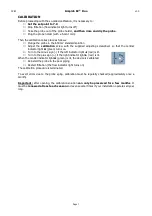
CCEI
Limpido EZ
®
Duo
v1.0
Page 3
The main advantage of this operating choice is to guarantee in all cases (even in the case of a power
failure) the same normal or reverse production times and, as a result, to ensure the best possible
descaling of the cell (enhancing production quality and equipment durability).
PH REGULATION
pH or the potential Hydrogen measures the degree of acidity of the water. Its value is between 0 and
14. A solution whose pH is equal to 7 is neutral. If it is less than 7, the solution is acid and if it is
greater than 7, the solution is said to be a base or alkaline solution.
For bather comfort, treatment efficiency and installation reliability, the pH of the pool water must be
maintained around 7.
A pH between 6.8 and 7.6 is generally considered to be correct.
A water which is too acid (pH <6.8) is aggressive for
mucosae, favours the corrosion of metal parts and can
damage plastics (liners).
A water which is too base (pH>7.8) can also be
aggressive (caustic) and significantly reduce the
efficiency of chlorine. Thus, when the pH increases
from 7.2 to 8.2, the percentage of active chlorine
decreases from 70% to 20%.
In addition, pH has systematically a tendency to
increase due to the presence of salt in the water,
making pH regulation particularly useful.
To obtain the best treatment efficiency, it is therefore indispensable to maintain the pH of the water
between 7.0 and 7.6.
For information, the table to the right allows
determining the required production time
versus the basin volume, the pH for a water
temperature of 25°C.
Since the water temperature varies during the
season, the filtration time has to be adjusted
to increase production when the water
temperature rises and to decrease production
when the temperature drops.
To avoid any possible measurement errors, it is recommended
to check the calibration of the
probe once a month
. To do this, simply follow the instructions in the CALIBRATION section.
EQUIPMENT DESCRIPTION
ELECTROLYSIS CELL
FLOW DETECTOR
PH PROBE
Your system’s essential element,
the cell, is equipped with solid
plates made of titanium treated
with ruthenium oxide. It is specially
designed to offer a maximum
service
life
and
to
limit
maintenance operations.
The flow detector delivered
with
Limpido EZ Duo
prevents the electrolyser
from operating in the
absence of flow or during a
backwashing. It prevents
any risk of hydrogen
accumulation or excessive
heating and thus reinforces
the device’s safety.
The pH probe is made up of
electrodes which apply a voltage
proportional to the water’s pH. The
pH probe is fragile and must be
carefully handled. It must be kept
immersed in an aqueous solution.
Volume (m
3
).
pH
40
60
80
100
6.8
2h00
2h50’
3h50’
4h50’
7.0
2h10’
3h15’
4h20’
5h30’
7.2
2h30’
3h40’
5h00’
6h15’
7.4
3h00’
4h30’
5h50’
7h20’
7.6
3h40’
5h25’
7h15’
9h00’
7.8
4h40’
6h50’
9h15’
11h30’
Free Chlorine
0
10
20
30
40
50
60
70
80
90
100
5,5
6,0
6,5
7,0
7,5
8,0
8,5
9,0
9,5
pH
%






























